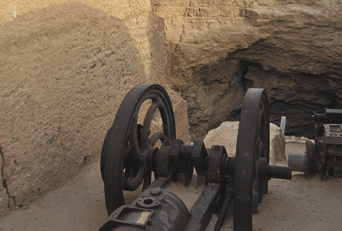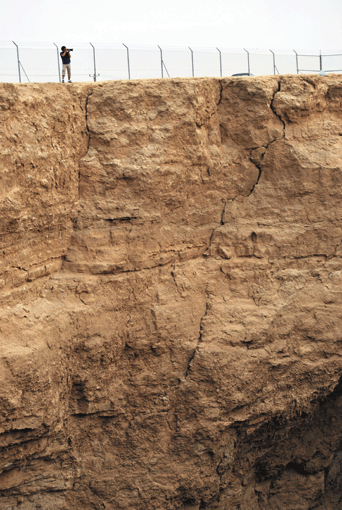

Al-Kharj Memories
Silent Springs
 |
They have all run dry, but remain a tourist’s delight
By: Abeer Alfowzan
Photos: George Pontino
The roar of gushing waters has fallen silent amid the vast desert environs of Al-Kharj, some 80 kms southeast of Riyadh. But beneath the earth’s surface lie hidden memories and lost tales of tranquil springs which were rich in water decades ago.
Al-Kharj is well known for its fertile farms and date palms. It is an agriculture base and an important center for allied industries mainly because of the easy availability of fresh water. The oasis is often referred to as the region’s “food basket,” where dairy products, like cheese and yogurt, and farm products, like vegetables and dates, are produced.
Source of water
The springs with their seemingly endless currents were a major source of water to the entire neighborhood. They flowed throughout the region including the largest town, Al-Sayh. The town derives its name from the Arabic word ‘asyah’ which means springs that flow all year long.
The springs now wear a forlorn look, but are an important archaeological site regularly visited by Saudis for their nostalgic value and by tourists looking for some respite. Today, fresh water is brought to the surface with the help of aging Blackstone water pumps. The romantic would find strong emotions in the reverberation of the machines echoing the fertile ages of flowing spring waters, eternally engraved in memory. An overwhelming sense of nostalgia prevails, recalling those times of flourish when water flowed incessantly through the irrigation canals. For the old-timer, the birds fluttering with the first sound of firing engines bring tears of emotions over the lost days.
Rare characteristic
Springs are natural subterranean cavities. The Al-Kharj springs were distinguished by a rare characteristic – they remained naturally cool in summer, and warm in winter, with a few sulphurous mineral water openings. These traits created a magnificent atmosphere for visitors to enjoy. It was the perfect place for Riyadh inhabitants with the vast farmlands irrigated by the springs adding to the perfect, rustic setting.
The spring at the southwest of Al-Sayh is named Om Al-Dal’a. Another is the Samha Spring, known for its flowing waters, and considered one of the oldest and most popular springs. Other wells are Ein Farzan, and Om Khesa.
According to the Saudi Commission for Tourism and Antiquities, the city has grown ten-fold in the past 20 years, with an estimated population now of about 250,000. It still holds many of the traditional mud-brick homes with wooden ceiling beams supporting roofs made of dried palm leaves and mud. Modern buildings now surround the old section, a testament to the recent boom.
Depleting water levels
In the last two decades, the water levels at the springs depleted mainly due to extraction from its feeder layer following the widespread drilling of artesian wells to irrigate larger agricultural lands. In course of time, the natural flow of water from the springs ceased. The springs gradually depleted, especially the shallow ones, with depths ranging from five to 15 meters. Soon, the deeper waters dried up as well, leaving behind nothing but ash and stone.
The “seven springs area,” as the vicinity is referred to, is located on the Delm-Kharj road. It is now a fenced out, hazardous place with sign boards warning visitors against sudden landslides. When we approached the place, the openings in the ground were huge, cracks were visible all over. The inner spring walls seemed ready to cave in any moment. Complete silence prevails, violated only by voices of tourists and clicks of cameras. One may spot a few inhabitants and poor workers.
As we were beginning to leave, we got a glimpse of the dilapidated mud houses which have survived a whole century. One may find it difficult to believe that this was once a spot of lush greens and flowing streams. The fallen walls are reminiscent of a bygone era where the springs have died as their waters dried, just as uncared houses crumble when their owners die.